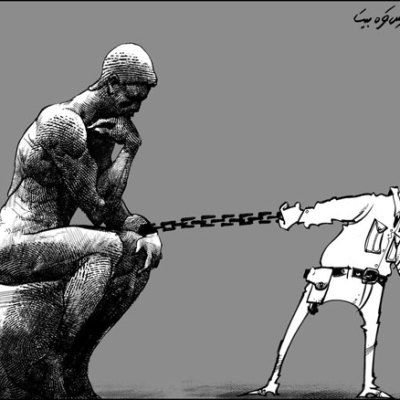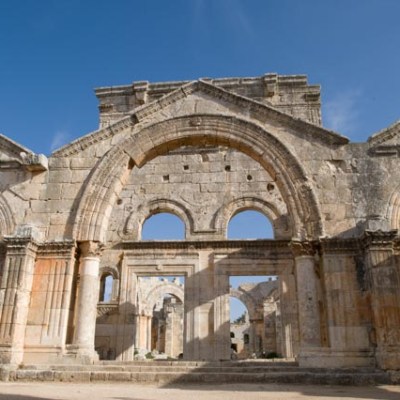Shortly after Jerusalem falls to the Crusaders in 1099, a Damascene judge called Abu Saad al-Harawi arrives at Baghdad’s great mosque and begins ostentatiously eating bread. It is Ramadan and an angry crowd gathers: ‘How dare you eat in the mosque when other people fast?’ Having got their attention, al-Harawi climbs the pulpit to sing a lament: ‘We have mingled blood with flowing tears and there is no room left for pity…your brothers in Syria have no dwelling place save the saddles of camels and the bellies of vultures.’
Given current events in the Middle East, this scene from Egyptian video artist Wael Shawky’s Cabaret Crusades feels spookily resonant. When I meet Shawky in Turin, where he has two exhibitions running concurrently until February (alongside an exhibition of his drawings at Lisson Gallery in Milan), he insists that when he conceived the sequence Syria was peaceful. ‘I mean, seriously, there was nothing at all,’ he says, in his boyish, earnest tone. By a grim twist of fate, though, the three films that make up Cabaret Crusades (2010–15) are set mainly between Damascus, Homs, and Aleppo – the three centres of power in the current Syrian conflict. ‘This is so weird,’ he tells me, shaking his head at the coincidence.
Cabaret Crusades: The Path to Cairo (film still), 2012, Wael Shawky. Courtesy Sfeir-Semler Gallery, Beirut & Hamburg and Lisson Gallery, London; © Wael Shawky
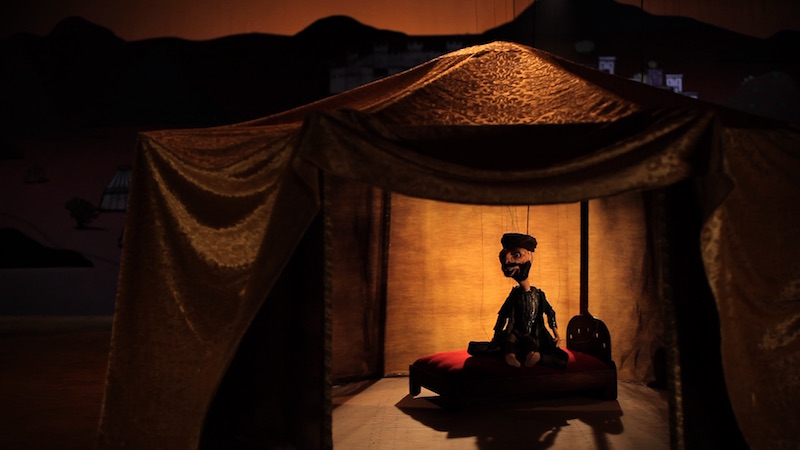
What makes it weirder is how Shawky tells the tale. Rather than real actors in medieval garb – in the style of Ridley Scott’s epic Kingdom of Heaven (2005), or the popular Arab television series Omar (2012) about an early caliph – Cabaret Crusades has intricately created marionettes playing all the major figures, from Pope Urban II to Saladin. His perspective is also unusual. Rather than using Western chronicles, he uses Muslim sources as recounted by the novelist Amin Maalouf in his Crusades Through Arab Eyes (1983). All three videos and 26 of the marionettes are being shown in the atmospheric surroundings of the Museo d’Arte Contemporanea at the Castello di Rivoli just outside Turin – which, by another happy chance, overlooks a Crusader route used by local monks. Anyone catching five or ten minutes in the gallery is bound to be intrigued by Cabaret Crusades; but to appreciate the depth of the work requires multiple viewings. Luckily, Shawky is an artist to whom it’s easy to become addicted.
Wael Shawky (the ‘k’ is silent) was born in Alexandria in 1971. He spent his childhood in Mecca and his work still bears the imprint of Islamic aesthetics. After graduating from art school in Alexandria in 1994, he went to Philadelphia to study for an MFA. He won an Ernst Schering Foundation Art Award in 2011, and is recognised as one of the most original video artists around. His early work shows a fondness for surreal juxtaposition. In The Cave (2005), Shawky filmed himself walking through a German supermarket reciting the Qur’an by heart. These days speaking Arabic in public can get you funny looks. But the passages he chose are respected by Eastern and Western traditions – the Islamic ‘Companions of the Cave’ are the Christian ‘Seven Sleepers of Ephesus’, found in the Golden Legend. There were also oblique parallels with Egypt under Hosni Mubarak’s dictatorship. In the story, the men and their dog escape a tyrant by hiding in a cave, where God grants them slumber until a better ruler appears.
Cabaret Crusades: The Secrets of Karbala (film still), 2015, Wael Shawky. Courtesy Wael Shawky and Sfeir-Semler Gallery, Beirut & Hamburg; © Wael Shawky
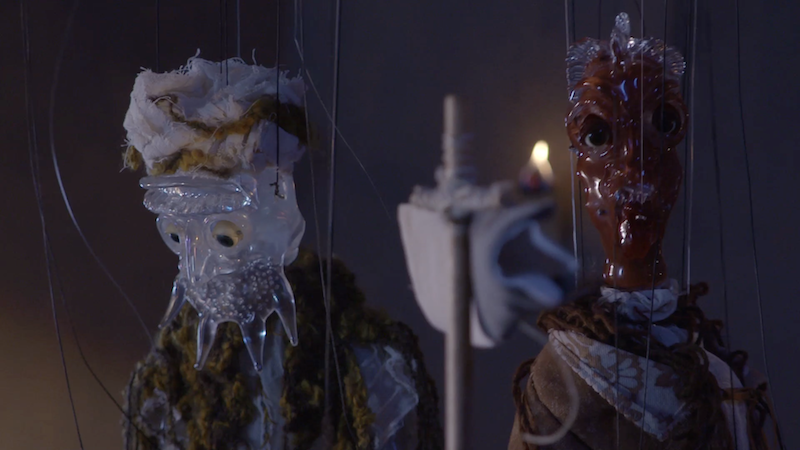
Shawky touched more explicitly on politics in 2007 with Telematch Sadat, in which children re-enact the 1981 assassination of President Anwar Sadat. He drew inspiration from a German television programme popular in the Arab world called Telematch, in which rival towns compete in a series of physical challenges, all in fancy dress and to a zany soundtrack – a bit like It’s a Knockout. The same childlike treatment of serious subject matter would become a running theme in Cabaret Crusades.
Shawky tells me that he chose marionettes for their endearing, naive quality, which makes them superior to actors. ‘You can see yourself, project yourself on a marionette in a way that you can’t with a professional actor – even if it’s Al Pacino because you can never forget you’re watching someone acting.’ He echoes the German playwright Heinrich von Kleist, who in his 1810 essay, ‘On the Marionette Theatre’, has a puppeteer argue that ‘where grace is concerned, it is impossible for man to come anywhere near a puppet.’ (Shawky has recently illustrated the essay with his own drawings.)
For The Horror Show File (2010), the first film in the Cabaret Crusades series, he repurposed 120 wooden marionettes that were rotting in the basement of the Lupi Collection in Turin. With the aid of the Pistoletto Foundation, ‘we changed the costumes and fixed the mechanisms inside them’. Their peeling paint and chipped faces evoke the ravages of Justinian’s Plague in 541, which opens the Prologue. It might seem strange to begin 650 years before the Crusades were launched, but Shawky takes the long view. Perhaps 50 million people died in that plague, making the Byzantine Empire ripe for Arab conquest 100 years later – a takeover that eventually prompted the Christian reconquest.
Marionette from Cabaret Crusades: The Secrets of Karbala, 2014, Wael Shawky. Courtesy Sfeir-Semler Gallery, Beirut & Hamburg and Lisson Gallery, London; © Wael Shawky

The next two films, The Path to Cairo (2012) and The Secrets of Karbala (2015), are more ambitious – the latter is feature-length. For them, Shawky designed his own marionettes, first using ceramics and then Murano glass. Gradually, the figures become less naturalistic and more animal-like, resembling the African mask collection Shawky studied at the Met in New York. As the wars drag on, both Franks and Arabs become more brittle and translucent, drained of humanity. Standing next to a set of the foot-high marionettes, Shawky describes the challenge of creating them. The biggest question was, ‘How to find the right traditional craft to connect with the story?’ He supervised the glasswork at the Adriano Berengo studio in Venice. That city plays a crucial part in the narrative, as The Secrets of Karbala ends in 1204 with the Venetian Doge sacking Constantinople. So Venice is a source of beauty and cruelty – a typically ironic touch from an artist who enjoys playing with conventional assumptions.
Only once in the series does a marionette entirely reflect its character’s villainy: Shimr ibn thil-Jawshan has huge teeth, a skeletal head and pit-black eyes. Shimr is a notorious figure in Islamic history. He murdered the Prophet Mohammed’s grandson in 681 in Karbala (that is the secret of the title), precipitating the Sunni-Shia split. While the Crusades were being fought, says Shawky, ‘there was another parallel conflict between Sunni and Shia. Of course people don’t talk about it a lot but it exists.’ Before he retook Jerusalem, Saladin destroyed the Shia Fatimid Empire in Egypt – which he regarded, if anything, as a more significant foe than the Franks. ‘It was important to start the last film with Karbala and end with the attack by the Catholics on Orthodox Constantinople. To show that this was not a religious war at all: it was absolutely about power and economics, just like when the grandson of the Prophet Mohammed was killed, it was simply for power.’
Just as with Shakespeare’s histories, reading the sources helps you work out what the artist has chosen to focus on or has refashioned. At the siege of Antioch in 1097, the city’s leader expels his Christian subjects in case they betray him. But the guilty man is one of his own, a disgruntled armorer who laughs manically as he opens his window to the Franks. (At this point the film, usually straight-faced, goes a bit Team America.) Look closely, though, and you notice the window is designed as an upside-down cross – a hint that the Crusaders are not exactly following in the footsteps of the Prince of Peace. As both Frankish and Arab chroniclers attest, the starving Franks succumbed to roasting and eating dead Muslims. The scene in which a marionette corpse is turned on a spit is gruesomely funny.
Initially Shawky thought he should make Cabaret Crusades in English to suit an international market. ‘Then I discovered this is absolutely wrong and since it’s based on the Arab historians, it has to be extremely classical Arabic, completely.’ The choice to make all the characters – sultan or pope – speak Arabic blurs the lines between the two sides, and draws a clear one to the present day. When Pope Urban II delivers his belligerent 1095 sermon calling for a crusade, he lambasts a ‘filthy race’ occupying Christian ground. He reminds you of George W. Bush calling for a ‘crusade’ for freedom after 9/11, but also Osama bin Laden, who in similar classical Arabic would condemn ‘filthy’ Westerners occupying the Muslim holy lands.
Marionette from Cabaret Crusades: The Secrets of Karbala, 2014, Wael Shawky. Courtesy Sfeir-Semler Gallery, Beirut & Hamburg and Lisson Gallery, London; © Wael Shawky

Perhaps the most ravishingly complex moment in the whole sequence features one of its few female personalities. Princess Alice, the daughter of Baldwin II of Jerusalem, is portrayed as a long-lashed camel marionette. (This is a compliment: the word for beauty in Arabic, jameel, is related to the word for camel, jamal.) She is a second-generation Crusader gone native. ‘The people of Antioch,’ Shawky says, ‘were Muslims who loved Alice very much because she was sympathising with them more than the Crusaders.’ She threatened an alliance with Aleppo until her father quelled her resistance. She begged forgiveness. ‘I found the best way to express this was to give her some verses from the Song of Roland,’ Shawky tells me. Up in her tower, Alice sings a seductive passage from the medieval French epic about Charlemagne’s victory over the Muslims: ‘Not a Muslim did there remain, / But confessed was Christian or else was slain.’ Shawky explains that ‘It’s a fantastic song. It shows that the more you are cutting off heads, the closer you are to God. It’s like a Christian version of jihad!’ Like his marionettes, Shawky can be unnervingly straight-faced.
Each film has a distinctive visual language. The muddy colours of The Horror Show File reflect the medieval Europe where the story begins. The Path to Cairo borrows from brightly-coloured Islamic miniatures, especially those of the 16th-century Bosnian cartographer Matrakçı Nasuh. ‘In Aleppo we used his map as a basis, but made it more like a pop-up book.’ The pink towers in The Secrets of Karbala, recreated full-scale in the Castello di Rivoli, were inspired both by Matrakçı and by Giotto’s frescoes in the Scrovegni Chapel in Padua. Shawky is foreshadowing the Italian victory in the third film’s final scene – and the coming Renaissance.
Carolyn Christov-Bakargiev, director of the Castello di Rivoli and the curator of the show, tells me that Shawky believes, ‘We are all like marionettes, manipulated by forces we cannot see.’ He allows the strings to be obviously visible in the films: every step and speech is controlled by a higher power – God perhaps, or the historian, or the artist. But the gravity-defying marionettes have a life of their own; their movements are never fully under the puppet-masters’ control. They are free and unfree at the same time: in other words, disconcertingly human.
At the Fondazione Merz in central Turin, Shawky has complementary sets of films. Al Araba Al Madfuna (2012–16) is a mysterious work that brings together ancient Egyptian lore, folk-tales, and popular Arab cinema. In the three videos, children dressed as adults – boys with moustaches and turbans, girls dressed as stern matrons – sit together in their village telling each other fantastical stories. For example, the people who lose the ability to speak and invent a new sign language through clapping; or a shaggy dog story about which animal is luckiest for the village to adopt. The children mime the words with adult voices dubbed over in Shawky’s favoured classical Arabic.
Al Araba Al Madfuna I (film still), 2011, Wael Shawky. Co-produced by Sharjah Art Foundation & Wiener Festwochen; courtesy the artist & Sharjah Art Foundation; © Wael Shawky

The third video, premiered in Turin, was filmed near a village called Al Araba Al Madfuna, at the temple to Seti I (c. 1290 BC). ‘I had to get a lot of permissions and bribes to do this,’ Shawky says, but he says it was worth it. The Osireion, situated behind the temple, is a strange place. ‘It’s full of myth, just like the history of the Crusades, but even more complex. Because we don’t really know what it was for.’ The Book of the Dead on the walls implies it was a tomb of some kind; a waterway connects underground chambers and some speculate it was where the Pharaoh was bathed before mummification. Even the source of the water is unknown. ‘Some say that it’s coming from the river, the Nile, and many people say it’s got nothing to do with the Nile. I like the uncertainty: it’s where you make art.’
We watch the children ride into the Osireion by boat, examine the hieroglyphs, make gestures, form the shape of a scene. But at the same time, they recite a story which is not about ancient Egypt at all – instead it’s taken from the Egyptian writer Mohamed Mustagab’s 1983 collection of parables. (Once more note Shawky’s taste for weird juxtapositions.) Mustagab’s story tells how for a long time the village used sunflowers to decorate their agricultural fields. One day, a farmer discovers the flower has edible seeds which can be sold to the neighbours. The village becomes wealthy, leaves behind its old-fashioned ways and starts to import all its food.
I put it to Shawky that the modern equivalent of sunflower seeds is oil, whose discovery has enriched the Arab world and caused no end of trouble. (This is prefigured in The Horror Show File, when the Arabs are shown filling barrels up with thick black oil, which they use both in their medicine and to make Greek fire.) He allows the interpretation, but I suspect he feels it is a bit obvious. ‘It also tells you how a country, for example, decided to close all its factories and just import Chinese and Turkish goods.’ Another parallel with modern Egypt. In fact, the film could be set in any period, its temporal strangeness intensified by his decision to invert the colouration so that the green water of the Osireion turns purple, and the stars are dark dots in a bright night sky.
The metaphor of multiple time frames is carried into how the Fondazione Merz present the videos. Abdellah Karroum, director of the Arab Museum of Modern Art (Mathaf) in Doha and the show’s curator, explains that the first Al Araba Al Madfuna film is the furthest away from the viewer, down dark steps and in a tomb-like basement. ‘You excavate the oldest film first,’ Karroum tells me, ‘before going up to see the more recent ones.’
Installation view, ‘Wael Shawky: Al Araba Al Madfuna’ at the Fondazione Merz, Turin. Photo: Andrea Guermani; courtesy Fondazione Merz
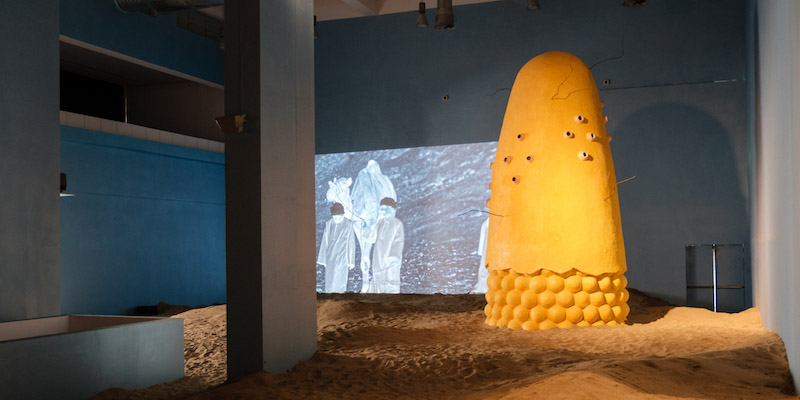
You are also encouraged to sit on artificial sand dunes, though when I am there no one is willing to spoil their designer Italian gear and instead they perch on the edges. Looming over us is a bulbous yellow tower punctuated with holes. It is a replica of the towers used as a backdrop for the second film. Shawky tells me he found them in a village between Alexandria and Cairo, many damaged with their honeycomb insides exposed. They could conceivably have dated from ancient Egypt or Crusader times but, Shawky discovered, they were built in the 1930s for catching pigeons. ‘But now they don’t use them so it became like a ruined city…really it was surreal to see this place.’ A place with a prosaic purpose – a ‘factory of meat’, in the artist’s words – has since taken on romantic and sinister connotations. The pigeons mated in the honeycomb holes – a literal love nest – while they waited to be slaughtered. I am reminded of the towers in Cabaret Crusades. The Antioch tower where Alice sings so charmingly of killing the enemy; the Tower of David in Jerusalem, from which its Arab defender peers at the Frankish army; the moated citadel of Aleppo, where civilians flock for protection. Immerse yourself long enough in Shawky’s work and everything seems to flow together in a stream of history and images.
Al Araba Al Madfuna, Drawings, 2015, Wael Shawky. Courtesy Lisson Gallery; © Wael Shawky
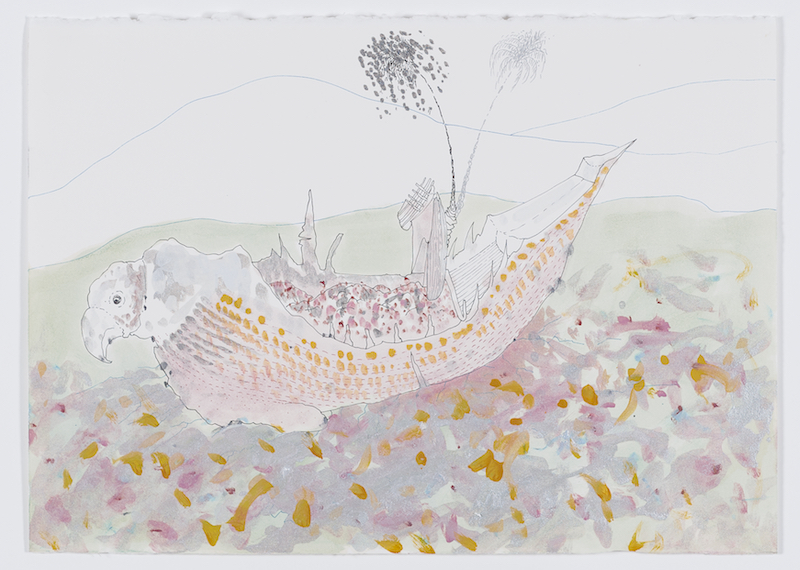
Shawky is a master of unexpected connections. He once spent eight months in Istanbul reading Sufi poets; he was trying to learn ‘how to kill your will and become a receiver, which means leaving yourself to God’. Struggling to put this into practice in distracting Istanbul, he booked a flight to the Kurdish borderlands. But he just missed the flight. On a whim, he took the next plane to wherever it was headed. He ended up in the Anatolian city of Konya at 2am. He asked a local man where he was. ‘This city is the shrine of Rumi,’ the great Sufi poet. ‘Okay,’ said Shawky, ‘I understand why I’m here.’ The best thing about his Turkey trip was the serendipitous experience in his final week. ‘Art can be a way of learning,’ he says, ‘let us say discovering.’
Wael Shawky’ is at the Castello di Rivoli, Turin, until 5 February ; ‘Wael Shawky: Al Araba Al Madfuna’ is at the Fondazione Merz, Turin, until 5 February.
From the January issue of Apollo: preview and subscribe here


